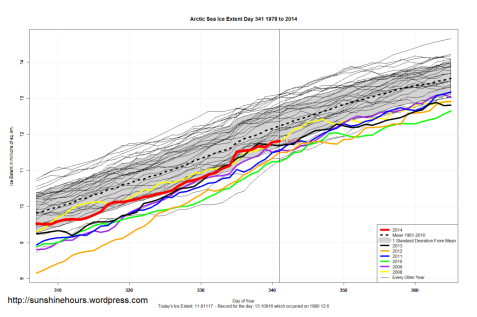






The Earth has always warmed and cooled.
The climate is complex and we do not understand it.
We know too little, based on a sample of just a few decades of empirical observations.
Over the past 165 years we had a warming of 0.76°C (+0.05 C per decade). It is far from unprecedented and far from alarming.
There has been a significant rebound of the Arctic ice cap since 2012.
The extension of the Antarctic ice cap has reached record levels.
97% of model projections failed (111 of 114 climate models were wrong)
Since the Cambrian/Ordovician CO2 levels fluctuated naturally within a 180 ppm and 8,000 ppm range.
During the Triassic and Jurassic CO2 levels were much higher than now (now: 400 ppm – then: between 1,800 ppm and 2,000 ppm range) with no sign of runaway global warming: oceans didn’t acidify, the biosphere thrived.
The Ordovician ice age occurred with CO2 levels in the 4,000 ppm to 5,000 ppm range.
Pleistocene glaciations occurred with stable CO2 levels (around 290 ppm to 300 ppm).
The last interglacial period (Eemian) was 5.0 C warmer than now with CO2 ppm levels of about 290 ppm to 300 ppm
The Holocene Climate Optimum was at least 2.0 C warmer than the present, with CO2 ppm levels around 260-270 ppm
Temperatures decreased by about -0.5 to -0.6 C between 1940 and 1970 even though CO2 levels were increasing
“Atmospheric CO2 follows temperature changes in Antarctica with a lag of some hundreds of years” (IPCC AR4)
CO2 level changes lag behind temperature changes: 1200±700 (Andreas Indermuhle et al., Atmospheric CO2 Concentration from 60 to 20 kyr BP from the Taylor Dome ice core, Antarctica, Geophysical Research Letters, Volume 27, Number 5, March 2000).
1000 years (Lowell Stott et al., Southern Hemisphere and Deep-Sea Warming Led Deglacial Atmospheric CO2 Rise and Tropical Warming, Science, Volume 318, Issue 5849, September 2007).
800 ± 200 years (Nicolas Caillon et al., Timing of Atmospheric CO2 and Antarctic Temperature Changes Across Termination III, Science, Volume 299, Number 5613, March 2003).
600 ± 400 years (Hubertus Fischer et al., Ice core records of atmospheric CO2 around the last three glacial terminations (Science, Volume 283, Number 5408, pp. 1712-1714, March 1999).
800 ± 600 years (Eric Monnin et al., Atmospheric CO2 Concentrations over the Last Glacial Termination (Science, Volume 291. Number 5501, January 2001).
900 ± 325 years (Landais et al. Two-phase change in CO2, Antarctic temperature and global climate during Termination II, Nature Geoscience 6, 1062–1065, October 2013).
Generally low confidence that there have been discernible changes over the observed record on lack of trends in extremes, exceptions are trends seen in temperature extremes and regional precipitation (but not floods) (IPCC AR5);
Unlike in AR4, it is assessed here…there is low confidence of regional changes in the intensity of extreme extratropical cyclones (IPCC AR5);
low confidence that any reported long term increases in tropical cyclone activity are robust (IPCC AR5);
current datasets indicate no significant observed trends in global tropical cyclone frequency (IPCC AR5);
The current assessment does not support the AR4 conclusions regarding global increasing trends in droughts (IPCC AR5);
Low confidence regarding the sign of trend in the magnitude and/or frequency of floods on a global scale – there is currently no clear and widespread evidence for observed changes in flooding (IPCC AR5);
No long-term acceleration of sea level has been identified using 20th-century data alone (IPCC 2007);
It is likely that GMSL (Global Mean Sea Level) rose between 1920 and 1950 at a rate comparable to that observed between 1993 and 2010 (IPCC AR5);
Antarctic sea ice extent is also projected to decrease in the 21st century (IPCC AR4)
Most models simulate a small decreasing trend in Antarctic sea ice extent, in contrast to the small increasing trend in observations… There is low confidence in the scientific understanding of the small observed increase in Antarctic sea ice extent (IPCC AR5)
The recent observed positive trends in total Antarctic sea ice extent are at odds with the expectation of melting sea ice in a warming world. More problematic yet, climate models indicate that sea ice should decrease around Antarctica in response to both increasing greenhouse gases and stratospheric ozone depletion.
Lorenzo M. Polvani, Karen L. Smith, Can natural variability explain observed Antarctic sea ice trends? New modeling evidence from CMIP5, Geophysical Research Letters, Volume 40, Issue 12, pages 3195–3199, 28 June 2013
For the Southern Ocean as a whole, sea surface temperature has decreased by approximately 0.6°C in December-February (0.4°C in the annual mean) while Antarctic sea ice cover has increased by approximately 9% in December-February (12% in the annual mean) during 1979-2011.
Fan, T., C. Deser, and D. P. Schneider (2014), Recent Antarctic sea ice trends in the context of Southern Ocean surface climate variations since 1950, Geophys. Res. Lett., 41, 2419–2426
[O]ur spatial analysis of Antarctic meteorological data demonstrates a net cooling on the Antarctic continent between 1966 and 2000, particularly during summer and autumn. The McMurdo Dry Valleys have cooled by 0.7 °C per decade between 1986 and 2000, with similar pronounced seasonal trends.
Peter T. Doran et al., Antarctic climate cooling and terrestrial ecosystem response, Nature, 415, 517-520 (31 January 2002)
Jay H. Zwally et al., Mass Gains of the Antarctic Ice Sheet Exceed Losses, NASA technical report, Jul 14, 2012.
Frezzotti et a. A synthesis of the Antarctic surface mass balance during the last 800 yr, The Cryosphere, 7, 303–319, 2013.
Curt H. Davis et al. Snowfall-Driven Growth in East Antarctic Ice Sheet Mitigates Recent Sea-Level Rise, Science 24 June 2005:
Vol. 308 no. 5730 pp. 1898-1901.
Gong, Y., Cornford, S. L., and Payne, A. J.: Modelling the response of the Lambert Glacier–Amery Ice Shelf system, East Antarctica, to uncertain climate forcing over the 21st and 22nd centuries, The Cryosphere, 8, 1057-1068.
Elizabeth R. Thomas, Gareth J. Marshall, Joseph R. McConnell, A doubling in snow accumulation in the western Antarctic, Peninsula since 1850, Geophysical Research Letters, Volume 35, Issue 1, January 2008.

Antarctica and the Southern Ocean have been *cooling* and the sea ice is trending upwards:
http://nsidc.org/arcticseaicenews/files/2014/10/monthly_ice_SH_09.png
Growing Antarctic Ice Sheets May Have Sparked Ice Age, Live Science, December 04, 2014
Solheim et al., The long sunspot cycle 23 predicts a significant temperature decrease in cycle 24, Journal of Atmospheric and Solar-Terrestrial Physics, Volume 80, May 2012, Pages 267–284
 “Annunciazione” di Carlo Crivelli
“Annunciazione” di Carlo Crivelli  Dettaglio della nube luminosa – “angeli”
Dettaglio della nube luminosa – “angeli”  “Battesimo di Cristo” di Aert De Gelder
“Battesimo di Cristo” di Aert De Gelder  “Esaltazione dell’Eucaristia” di Ventura Salimbeni
“Esaltazione dell’Eucaristia” di Ventura Salimbeni  “Madonna con Bambino e San Giovannino” di Sebastiano Mainardi o Jacopo del Sellaio
“Madonna con Bambino e San Giovannino” di Sebastiano Mainardi o Jacopo del Sellaio  Dettaglio del pastore e della nube luminosa
Dettaglio del pastore e della nube luminosa  dettaglio della “Natività” del Pinturicchio (“sole”)
dettaglio della “Natività” del Pinturicchio (“sole”) 




















